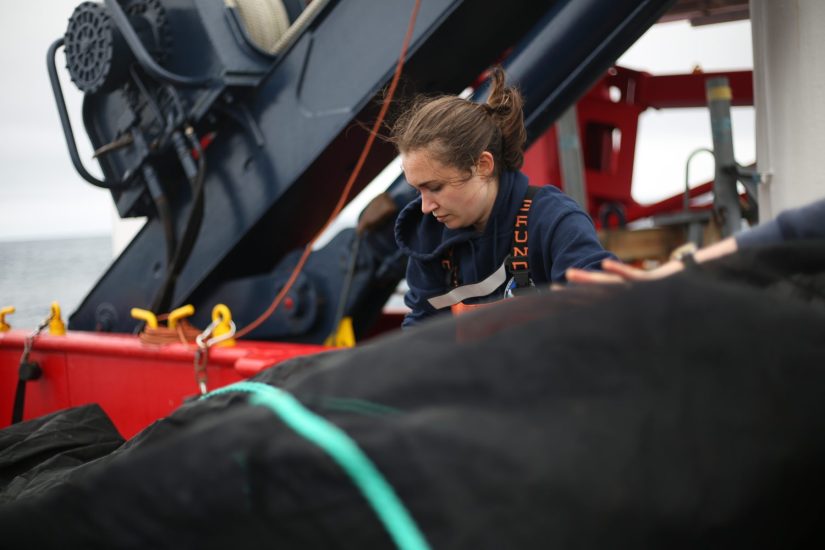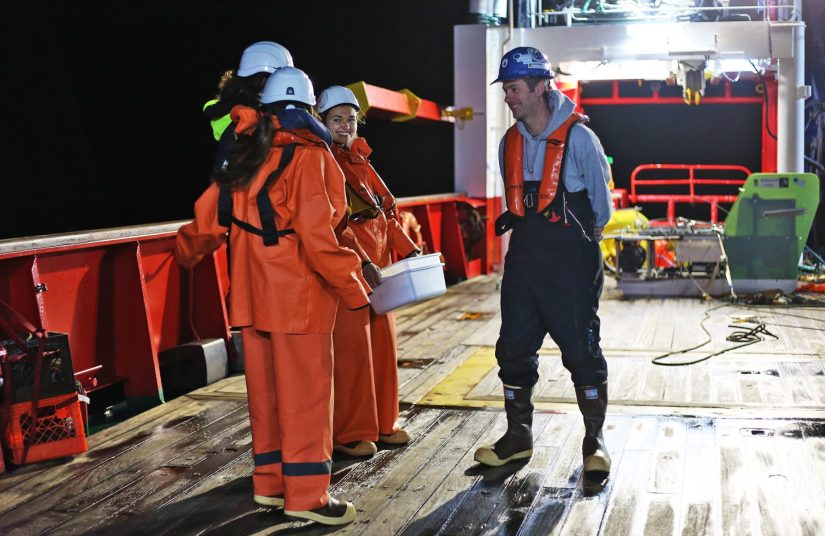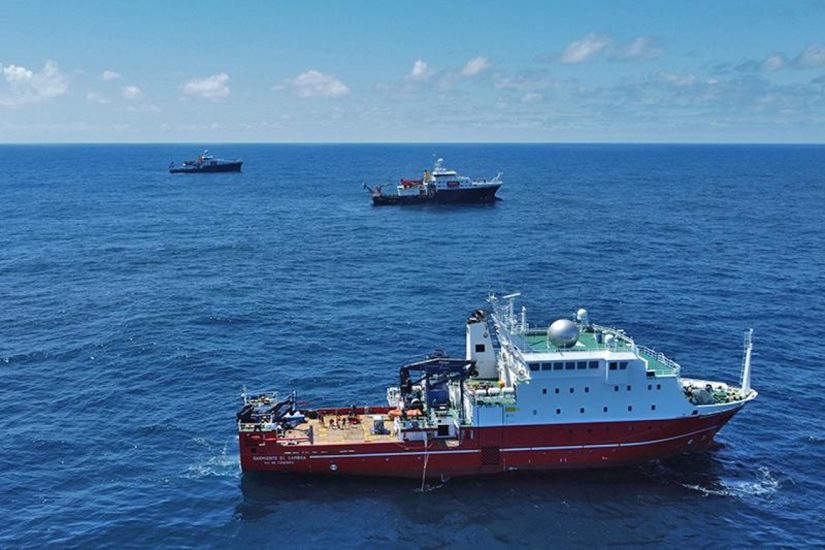New research led by SAFS doctoral student, Arial Brewer, documents the vocal repertoire of Cook Inlet beluga whales for the first time.
Salmon, scales, and spectrometry: analyzing historical fish scales to explore food web changes over time
For over 60 years, the Alaska Department of Fish and Game have collected scales from sockeye salmon in Bristol Bay. Now, these scales are receiving special treatment in a new project led by SAFS graduate student Grace Henry, who is conducting stable isotope analysis to examine how food webs in the North Pacific Ocean have changed since the 1960s.

Chemistry has always been Grace’s biggest interest: “I love chemistry, and for me, it’s the cornerstone of ecological science.” Working with stable isotopes in her pre-graduate studies, Grace wanted to use this method during her thesis work on food webs using historical archived samples.
Utilizing this novel method of Compound Specific Isotope Analysis (CSIA) with historical samples of salmon scales, Grace is exploring if salmon have changed their eating habits, and how ocean composition has changed over time.
“We know that were was a climate regime shift in the 1970s affecting Bristol Bay called the Pacific Decadal Oscillation. It’s similar to El Nino in that it’s a long-time period change in regional climate, and for some reason, this shift meant a lot more salmon were coming back to Bristol Bay,” Grace shared.
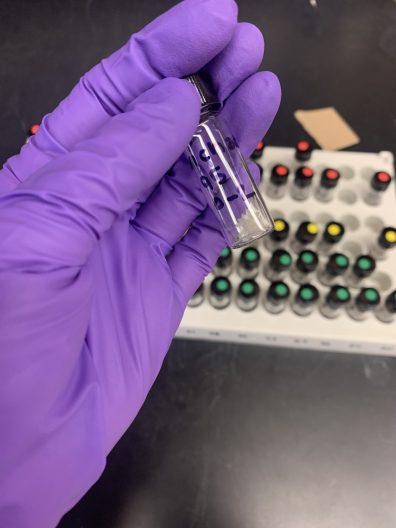
Grace hypothesizes that maybe part of this increase in salmon was because climate change altered the ocean composition in a positive way for the species. Salmon scales grow much like tree rings. They grow constantly through the salmon’s life and what the salmon is eating is locked into the stable isotopes of the scale. Examining these scales is a way to dig deeper into this hypothesis and see that shift reflected in the isotope analysis. “It’s also possible that this won’t be shown, and that will be interesting in itself as this suggests it will be something else that’s the cause,” she added.
Where do the scales come from? Collected during every season of the sockeye return to Bristol Bay since 1960s, people employed to work in counting towers at the mouth of every river would collect scale samples after conducting fish counts. “These scales are really cool because they save really easily and don’t degrade,” Grace said. “You don’t have to preserve them in a special mixture of chemicals, and so there aren’t any interactions with chemicals when doing the isotope analysis.”
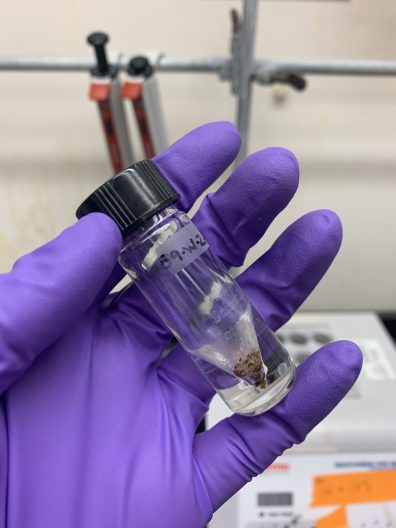
Explaining more about the method she uses for her research; Grace uses a gas chromatograph and mass spectrometer to run all her samples. Her process involves dissolving the scales in hydrochloric acid and then adding a few other chemicals to break apart the proteins into individual amino acids that she can analyze.
“This method is pretty new and not a lot of people use it. It’s exciting to be able to use this method and framework in my research to deliver new insights into the changing diet of sockeye salmon and the ocean composition of Bristol Bay over time,” Grace said.
So, what kind of insights can isotopes deliver with regards to salmon diet? Salmon can be considered generalists in their diets, eating whatever is available. In an ocean with small fish, this is what salmon would eat. If there is more zooplankton, salmon would eat that instead. Each thing has a very distinct isotope signature. If the isotope is a lower value, it’s zooplankton, and if it’s a higher value, this corresponds with small fish.
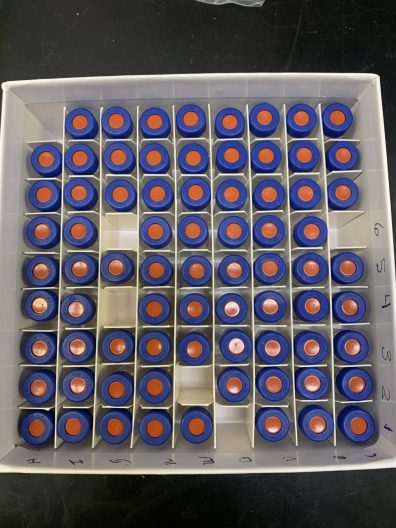
“Because salmon eat whatever is available, it’s possible to make assumptions about what is most abundant in the ocean based off what the salmon is eating. If the isotopes show that in the 1960s salmon ate mostly zooplankton, but today they eat mostly small fish, then it can be hypothesized that for whatever reason, the ocean composition has more small fish and fewer zooplankton than it once did,” Grace shared. “If these patterns can be connected to changes in climate, it may be possible to more accurately predict what the ocean composition will look like in another 60 years,” she added.
Grace is just at the beginning of this research project as part of her masters program thesis. Spending time in Alaska this summer in the same place where scales have been collected since the 1960s, she’s enjoying combining field elements of research with lab work involving stable isotope analysis, mechanical work and modeling.
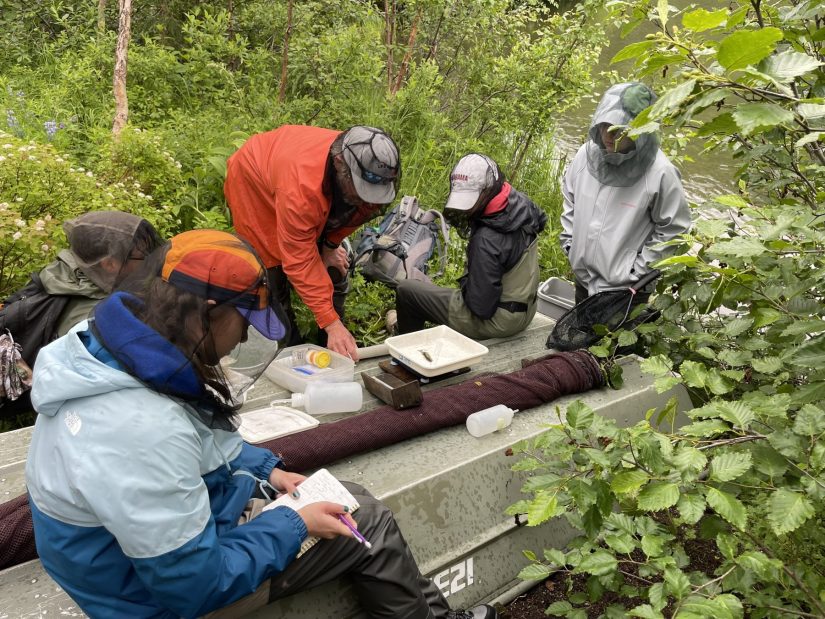
Part 2 of our video series featuring the Alaska Salmon Program now live
Watch Part 2 of a summer with the Alaska Salmon Program, now live, featuring the students who are essential to the program.
Studying toxic metals in fish in southeast Asia’s largest freshwater lake
In the largest freshwater lake in southeast Asia, Shorna Sabikunnahar is looking into the ecological and environmental drivers of toxic metals in resident fish.
Conducting her research on Tonle Sap Lake in Cambodia, which is part of the Mekong River system, Shorna is a SAFS PhD student in the Holtgrieve Ecosystem Ecology Lab (HEEL). Designated as a Biosphere Reserve by UNESCO, Tonle Sap Lake is one of the most diverse and productive ecosystems on the globe.
Collecting and sampling over 1000 samples of fish, water, sediment and other species such as mollusks and crustaceans, Shorna visited Cambodia in both the dry and rainy reason to build her sample collection from 10 different locations. Tonle Sap Lake faces a huge transformation depending on the season. In the dry season when it drains into the Mekong River, the lake length is over 100 miles. This grows more than five times in area during the rainy season, with water flowing from the Mekong back into the lake. This brings with it different nutrients and biodiversity, but also impacts levels of toxic metals.
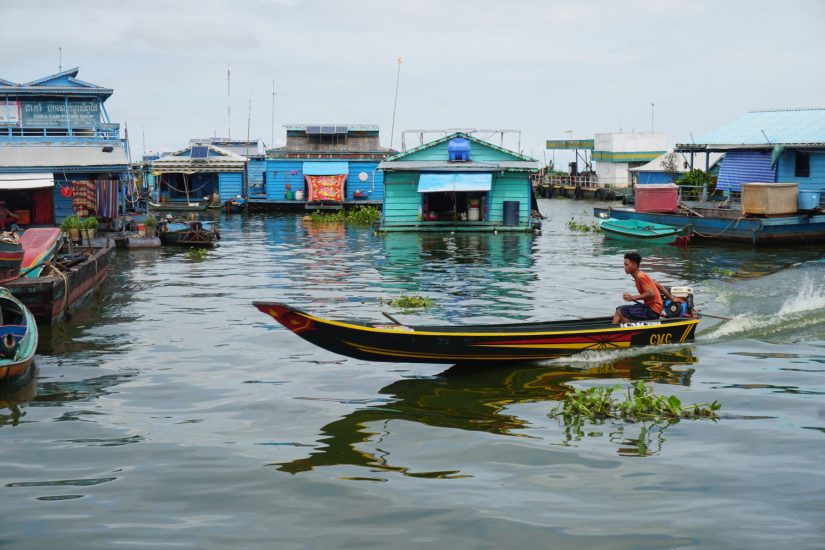
Shorna analyzed the presence and levels of toxic metals in 39 different species of fish found in the lake. The Lower Mekong River supports more than 60 million people, with 80% of their protein coming from fish within Tonle Sap Lake. Studying parts of the food web, including fish, is critical to shed insight into a number of different things: the fishery itself, if humans are receiving the nutrients they need from these fish, and if there are health risks posed by the level of toxic metals in fish. Some of the species of fish studied by Shorna include Parambassis wolffii, Pangasianodon hypophthalmus, Boesemania microlepis, Phalacronotus apogon, Ompok bimaculatus, Mystus, mysticetus, Hamibagrus spilopterus and Channa micropeltes.
Collecting water and sediment samples directly from the lake and fish samples from the floating villages and fish markets located on the lake, Shorna has found that it’s not always the bigger fish that have the highest level of toxic metals present, which is contrary to the usual pattern. In Shorna’s analysis, some of the largest fish had levels at the bottom of the range, whereas some of the smaller fish, hardly bigger than a finger, had the highest amount of metal concentrations. This wide and unexpected variance suggests that levels of toxic metals is driven by the feeding habits of fish such as what they are eating and where.
One of the assumptions in Shorna’s study was that climate change and numerous hydropower dams have a significant impact on the variation in toxic metal content in fish. Specifically looking at mercury, during flooding events when floodplains and forests are submerged, the decomposition of organic matter, such as leaves and other vegetation, begins. This process reduces the oxygen levels in the water and increases methylation. Methylation is the conversion of inorganic mercury into easily accessible methylmercury, which fish can readily accumulate in their bodies.
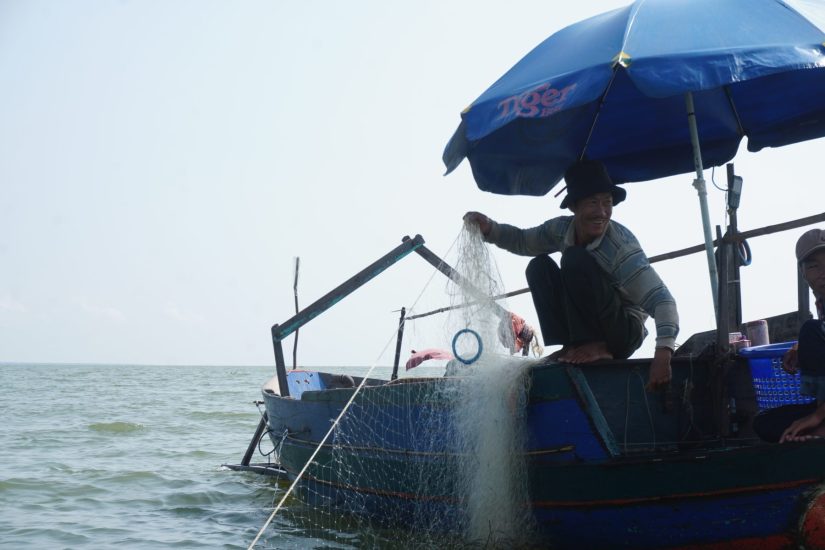
However, Shorna found that only the feeding ecology of fish (their feeding patterns, food sources, and trophic positions) influence mercury accumulation in fish. Environmental factors such as seasonal change and variation in water level throughout the year or flooding is not significant. This result is interesting because some previous studies in the Arctic found that environmental factors such as temperature influences mercury accumulation in fish. Another study in the Amazon River basin found that despite the absence of human-induced sources, fish contain relatively high levels of mercury due to the impact of annual flooding.
The next step in Shorna’s research is to analyze the fatty acids and other vitamins found in fish – the nutrients that humans eat fish to gain – as well as the toxic metals levels. But how do we know what fish people are eating? Household fish consumption pattern data already exists, and Shorna will combine this data on what people eat with her results on toxic metals and nutrient loads in fish. The aim? To see if these fish pose any carcinogen or non-carcinogenic risks to people as well as whether their nutritional requirements are being fulfilled or not.
The Mekong River is a huge and important area, and by studying one of the most important lakes in this system, Shorna’s work can provide deeper insight into the wider ecological system of the Mekong and the fish that call it home.
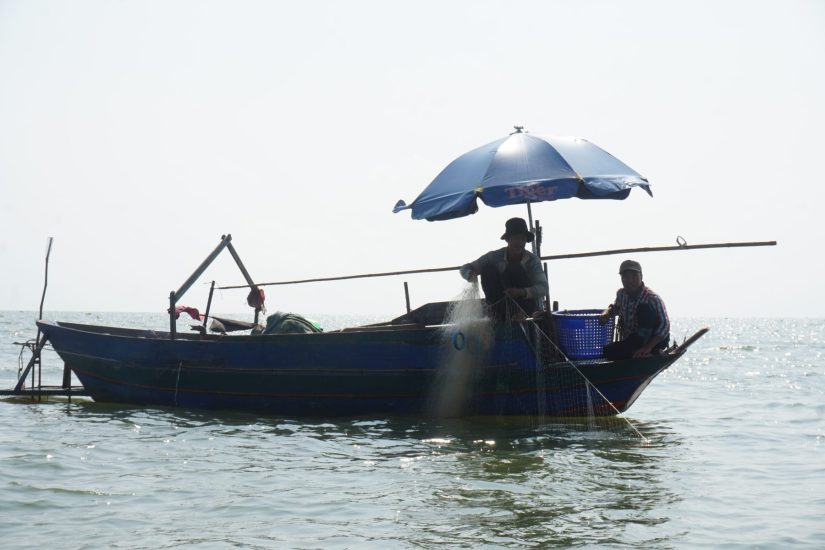
Multiple lines and levels of evidence for avian zoochory promoting fish colonization of artificial lakes
Understanding how obligate freshwater organisms colonize seemingly isolated ecosystems has long fascinated ecologists, with new research co-authored by Flavien Garcia and Julian Olden demonstrating possible bird-mediated colonization of lakes by European perch.
Diving deep into how fish impact carbon cycling in the ocean
Recently featured in Hakai Magazine’s article “All The Fish We Cannot See”, SAFS PhD student Helena McMonagle is conducting a deep dive into a hidden cache of fish that might play an unexpected role in how the ocean sequesters carbon. We caught up with Helena to find out more about it.
Since starting this research in 2019, I’ve been using data collected at sea and in the lab, along with bioenergetic models, to estimate how much carbon these mesopelagic fish, such as lanternfish, transport from surface waters into the twilight zone. Also known as the mesopelagic zone, the twilight zone spans from roughly 200-1000 meters (roughly a tenth to a half mile deep) and comprises the part of the ocean where there is still some sunlight, but not enough to support photosynthesis.
Despite this lack of primary production (the biomass generated by photosynthetic organisms like the microscopic, plant-like organisms known as phytoplankton), there is still a large biomass of fish and other marine life in this part of the ocean. Many of these twilight zone animals perform diel vertical migration, in which billions of fish and zooplankton all over the globe swim from the mesopelagic zone to the sea surface to feed where there is more food available. After filling their stomachs at night, they swim back down to the mesopelagic zone to hide from visual predators during the day.
At these deep depths, where carbon can be stored for longer time periods than if it stays near the sea surface, they release much of the carbon they consumed the night before by breathing out carbon dioxide, pooping, and in some cases getting eaten by predators that stay in the deep ocean, thus moving that carbon deeper.

One of the most abundant types of mesopelagic fishes that performs this daily migration is the lanternfish (not to be confused with the rarer anglerfish), a family of fish that includes almost 250 species. With my colleagues Tim Essington (SAFS), Joel Llopiz (Woods Hole Oceanographic Institution) and Ray Hilborn (SAFS), we found that estimations of how much carbon a single fish, like a lanternfish, transports each day into the twilight zone is associated with about a 6 fold uncertainty (McMonagle et al. 2023), which can be constrained a little further with great data coverage from the specific location where you’re estimating the carbon transport of that fish. Even then, scaling up to how much carbon entire populations of these fishes transport requires fish biomass estimation at a given study site, and biomass estimation is associated with even more uncertainty than all the bioenergetic uncertainties for an individual fish combined, based on preliminary results from a study that our team is currently working on.
As a result, even in a well-studied area, there can be well over an order of magnitude of uncertainty in the contribution of fish to biologically-driven carbon transport. One of these rare, well-studied areas is the Porcupine Abyssal Plain Sustained Observatory, which is located in the Northeast Atlantic, which has both long-term data collection as well as focused cruise efforts like one that I took part in during 2021.
This huge uncertainty from both biomass and bioenergetic uncertainty is based on preliminary results from my current project using data from the 2021 cruise. This data was gathered on board a Spanish research vessel operated by CSIC (Spanish National Research Council) in Spain, which was led by NASA EXPORTS (EXport Processes in the Ocean from RemoTe Sensing) and the WHOI Ocean Twilight Zone (OTZ) project. My fellowship funding was provided by the National Science Foundation’s (NSF) Graduate Research Fellowship Program.
Apart from biological carbon transport, physical and chemical processes also play a major role in moving dissolved carbon dioxide from the sea surface into the deep ocean, and together some portion of that carbon that is transported is also sequestered. Translating carbon transport into carbon sequestration is another can of worms in itself, because carbon transported into the twilight zone is not necessarily sequestered from the atmosphere on climate-relevant time scales. Therefore, the role that fish play in not only moving carbon deep, but locking it up from the atmosphere on climate-relevant time scales, is a topic that is largely still unstudied and unknown. 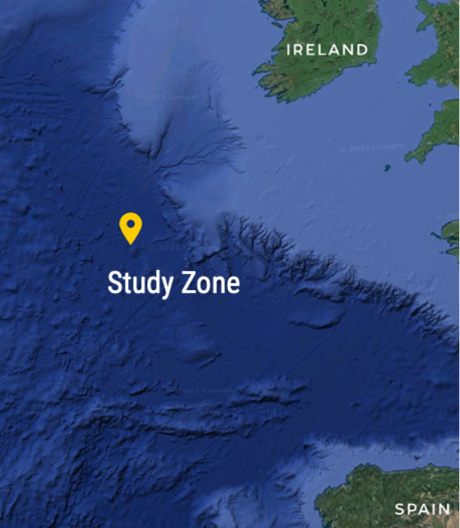
Acknowledging the difference between carbon transport within the ocean and carbon drawdown and sequestration from the atmosphere is part of my current research on fish carbon transport. My goal is to rigorously study the role of fish in carbon transport while avoiding miscommunication or misinterpretation of the carbon transport research into the realm of climate policy and carbon offsets, as this potential application will require much more research that we have currently available to verify with any certainty.
There is a large suite of climate mitigation strategies that we already know with high certainty will reduce atmospheric carbon dioxide concentrations and mitigate climate change. Although no one solution is a silver bullet that will curb human-driven climate change on its own, it’s important to urgently prioritize well-established climate mitigation strategies in climate policy, while exploring other mechanisms of carbon transport and carbon sequestration in the meantime in the research sector.
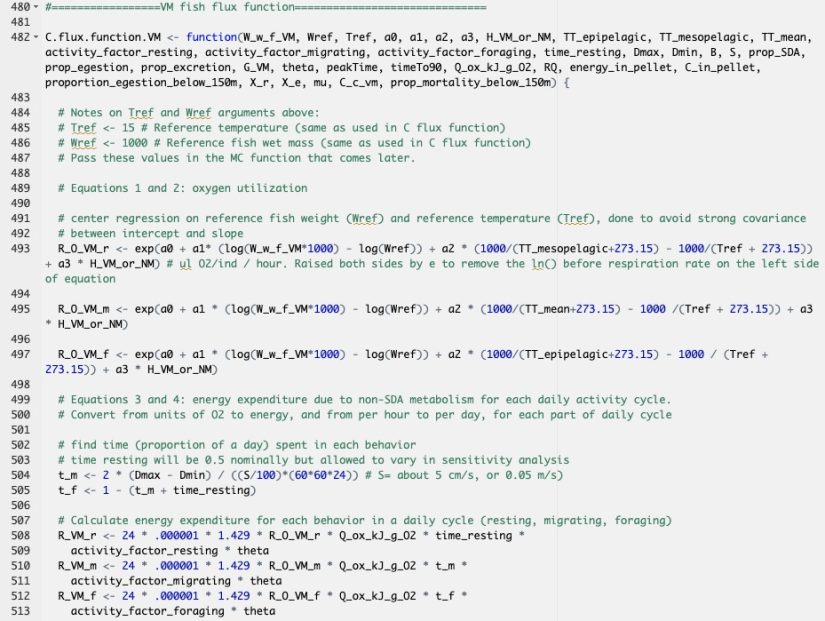
Working with the Port of Seattle during a Washington Sea Grant Fellowship
Selected as the 2022–2023 Washington Sea Grant Keystone Fellow, Ashley Townes spent a year working with the Port of Seattle’s maritime habitat team on advancing the development and implementation of innovative habitat restoration projects including kelp research, fish sampling with underwater remote operated vehicles (ROVs) and 360-degree cameras, and bankline monitoring to survey the condition and character of shorelines at port facilities in the Lake Washington Ship Canal, Shilshole Bay, Elliott Bay, the East and West waterways and the Duwamish Waterway. Also a PhD student in SAFS, we spoke to Ashley about her experience as a WSG Keystone Fellow, the knowledge and skills she developed throughout the experience, and how it fits in with her future career plans.
How did you get involved with the Washington Sea Grant Keystone Fellowship?
As a PhD student in SAFS, I had the amazing opportunity to be a teaching assistant and graduate student advisor with the Ronald E. McNair Post-Baccalaureate Achievement Program. This program is nationally recognized for its commitment to helping first-generation, low-income, and/or minority undergraduate students pursue PhD studies through research and scholarly activities. For two years, I was part of this wonderful team, assisting and working with students from diverse fields like molecular biology, atmospheric and oceanic sciences, astrophysics, philosophy, and dance.
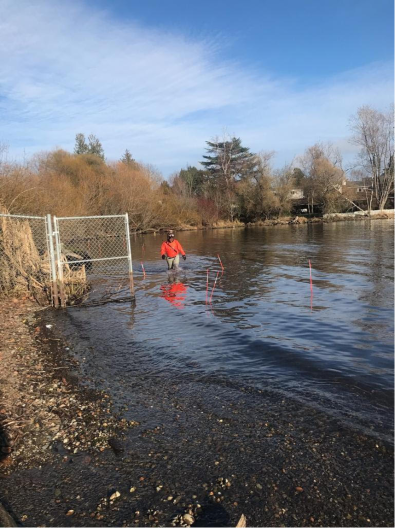
In my second year with the McNair program, I stumbled upon the Washington Sea Grant Keystone Fellowship. Intrigued, I clicked on the ad and found that the fellowship, and the host organization for that year which was the Port of Seattle, aligned quite well with my research interest and past professional experiences. It seemed like an ideal step for my career, especially since I am considering similar work post-graduation. The fellowship presented a unique chance to dig deep into the workings of a special purpose government and gain insights into the maritime industry sector.
In grad school, I’ve noticed there’s not a lot of talk about the different career options out there. Sure, a lot of us are aiming for that dream professor role or a spot at NOAA, which is awesome. But there are so many other amazing places to work, especially if you’re into fish ecology and aquatic science.
Take The Nature Conservancy, for instance, or King County Department of Natural Resources. There’s also the Department of Ecology and even the Port of Seattle. These organizations are all doing really important work and research in the fields of ecology, marine biology, fisheries, environmental science, natural resource management and they’re on the lookout for folks with both Masters and PhDs.
What’s cool about these places is that they value fresh perspectives. They’re not just looking for people to fill roles; they want someone who can bring new ideas and approaches to their projects. It’s a chance to make a real impact and see your education put to good use in some innovative and meaningful ways.
So, while the traditional paths are great, it’s worth exploring these other options too. You might find a career that not only fits your skills but also lets you contribute in ways you hadn’t thought of before. Plus, diversifying our career paths can only be good for the field in order to effectively tackle complex environmental challenges, including climate change.
Any thoughts for other students wanting to experience more research opportunities?
For students seeking to enhance their involvement in research opportunities, internships, and job experiences, a proactive and exploratory approach is key. Start by subscribing to newsletters from organizations that pique your interest. This can provide valuable insights into their activities and the nature of their work. Also, look into various blogs published by these organizations. This not only broadens your understanding of their operations but also helps you identify areas that resonate with your interests and strengths. Reflect on your skills, preferences, and the type of work that excites you. Consider feedback you’ve received about your work style and contributions; this can guide you in pinpointing potential career paths and skill areas to develop.
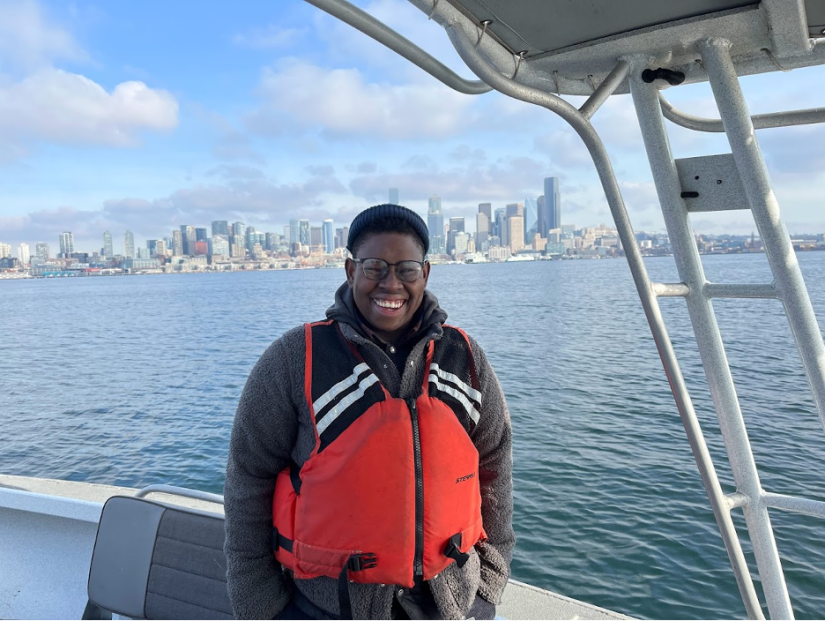
One practical step is to actively seek out mentors or advisors in your field of interest. These could be professors, industry professionals, or even senior students. They can provide invaluable guidance, help you identify opportunities, and sometimes even offer direct referrals. Remember, a simple conversation can open doors! Additionally, don’t hesitate to apply for positions, even if you feel you don’t meet all the criteria.
Furthermore, consider volunteering for research projects or internships, even if they are unpaid. The experience and connections you gain can be priceless. These experiences offer insider perspectives on various fields, including unique research opportunities, fellowships, and internships that may be available. These settings also provide a platform to network with professionals and peers, which can lead to valuable connections and insights into different career paths.
Lastly, be proactive in creating opportunities. If you can’t find an existing research project or internship that excites you, propose your own. Many professors appreciate initiative and may be willing to supervise an independent project or study.
Remember, the journey into research and professional experiences is as much about exploring your interests and building relationships as it is about acquiring specific skills. Be open, be curious, and don’t be afraid to step out of your comfort zone!
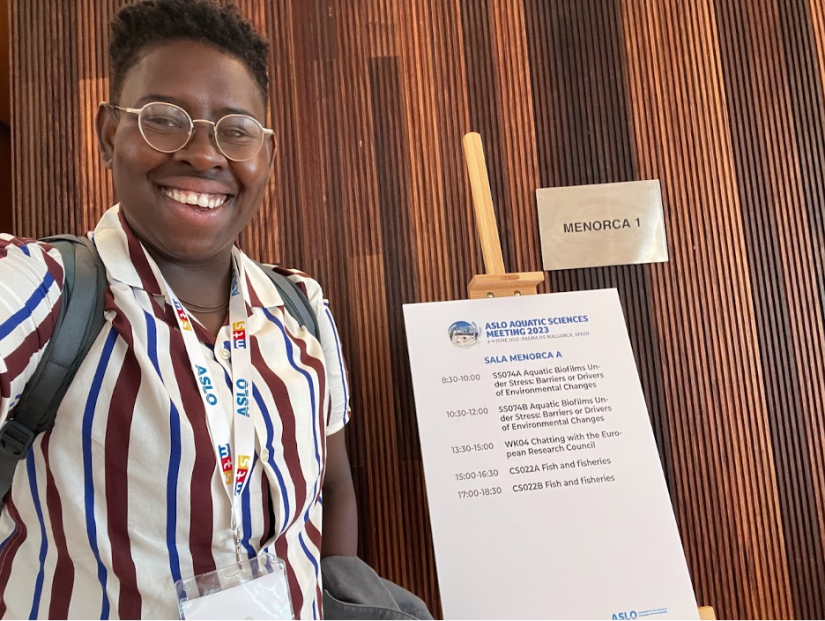
How has the fellowship experience contributed to your personal and professional growth?
During my time in the fellowship, I’ve built a rich network of connections, from inspiring mentors and industry experts to like-minded peers. These connections have not only enriched my understanding of the field but also opened doors to future collaborations and valuable advice. Taking on new challenges and responsibilities has significantly boosted my confidence, fostering a sense of self-reliance and a proactive approach in my career as well.
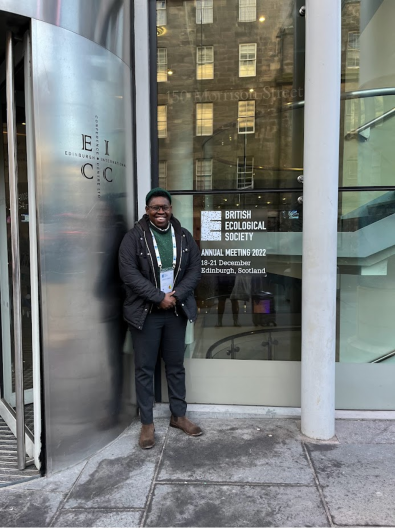
On a personal level, the experience has enhanced my adaptability, resilience, and cultural awareness. It has also strengthened my belief in my rightful place in this field and my ability to make important contributions. One of the most rewarding aspects was having my innovative ideas valued and leading small teams. Specifically, the fellowship offered me hands-on opportunities to apply my theoretical knowledge to real-world situations, deepening my understanding of salmon ecology in urban environments. This practical experience has been instrumental in shaping my long-term career goals as a research fish ecologist, allowing me to see the direct impact of my work in the field.
I would also like to highlight the terrific professional development opportunities that came with the Keystone Fellowship. The financial support provided to us fellows greatly empowered me to discover my own voice and refine my public speaking skills. In the past year, I had the privilege of presenting my doctoral research at three international conferences (Scotland, Spain and England), in addition to discussing my fellowship endeavors. Moreover, I actively engaged in three national conferences, substantially enriching my knowledge across diverse subject domains while fostering connections with fellow professionals. During these experiences, I not only got the chance to meet influential people like President April Croxton of the American Fisheries Society and esteemed marine biologist and scholar Daniel Pauly at the ASLO Aquatic Meeting in Spain, but also had a significant encounter during my research presentation in England. It was there that I was interviewed and featured in a video called “Reasons for Optimism.” After my oral presentation, I was approached by Nicholas Kevin Dulvy, a distinguished marine ecologist and multi-award winner. His unexpected invitation to join him and his colleagues at Simon Fraser University for discussions about my future left me profoundly amazed, deeply inspired, and honored.
What experiences were the most satisfying for you while working as a fellow?
Reflecting on my time as a fellow, some moments truly stand out. The highlight, without a doubt, was spearheading a pilot study research project. The study entailed carrying out a survey to evaluate the juvenile fish population, specifically salmon in the recently rehabilitated Duwamish River People’s Park, a riverside marsh in South Seattle The sense of achievement I felt when it succeeded was unparalleled, and I consider this project a major achievement in my career, alongside other significant works.
Being part of the Port of Seattle’s roundtable discussions was another enriching experience. There, I wasn’t just a bystander; I actively engaged in meaningful conversations, contributing ideas and learning from others. These discussions were eye-openers, broadening my perspective on various environmental issues.
What also added immense value to my fellowship was the opportunity to network with experts in environmental sustainability. Interacting with these professionals wasn’t just about exchanging business cards; it was about sharing a passion and vision for a greener future. Their unique insights and experiences not only helped me expand my professional circle but also deepened my understanding and enthusiasm for our collective mission.
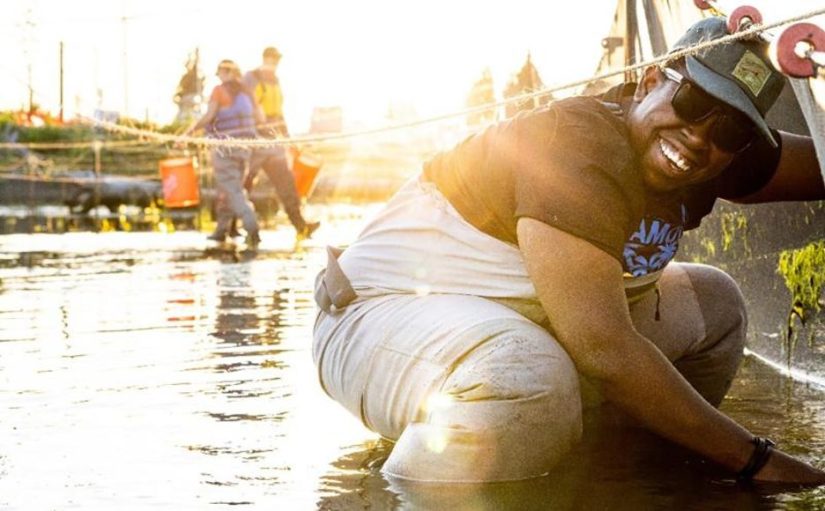
What kind of skills did you use from your studies during the experience?
Participating in this fellowship was a transformative experience, allowing me to bring the theoretical knowledge and research expertise I’ve cultivated during my PhD studies at SAFS into the dynamic realm of practical application. It was here that I truly refined my skill set, integrating advanced quantitative methods and research strategies into my professional toolkit. This opportunity enabled me into a real-world challenge: the restoration of salmon habitats.
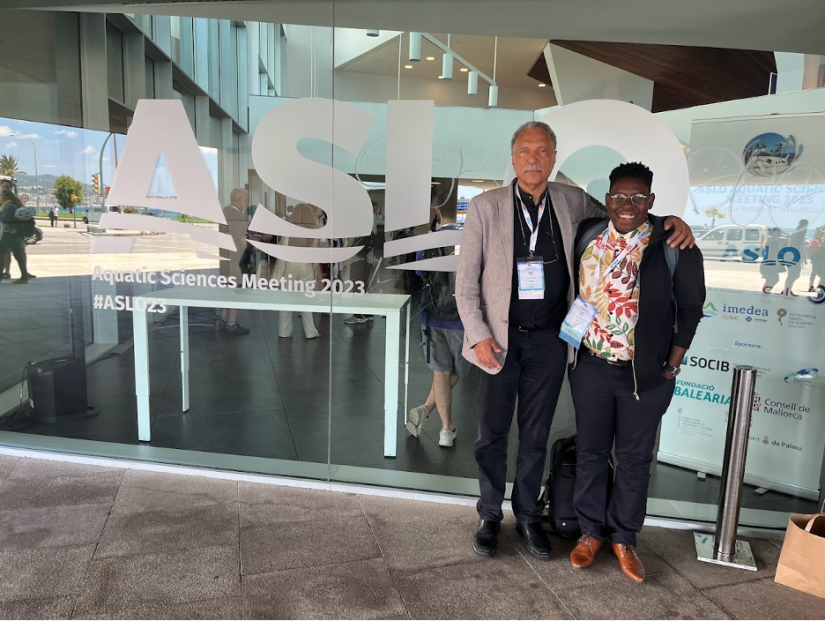
A standout moment was the experimental design and execution of my pilot study. For sampling, I primarily used a small ROV and a 360-degree camera. The two main objectives of the study were to: 1) assess the feasibility and effectiveness of using cutting-edge technology, including a 360-degree video camera and ROV within the context of a restored shallow marsh environment; and 2) determine whether the 360-degree video camera can effectively capture the presence of fish within the restored marsh environment, and to use the camera’s AI software for species identification and counting. This included a thorough evaluation of the camera’s capability to capture clear visual data. This application of high-tech technology has returned inspiring results, even capturing the movements of juvenile salmon as they venture into the marsh area of DRPP during high tide. I knew this project was a risk but in my heart, I also knew, regardless of the outcome, this process would yield valuable insights into the potential of various sophisticated technologies not commonly used in fish monitoring. As I was gearing up to implement the study, two quotes frequently came to mind, giving me a boost of confidence and the belief in my own capabilities:
“New innovations are born from creative thinking. Thus, it’s essential to nurture and support such creativity in every possible way.” – attributed to George Washington Carver.
“Through keen observation and thoughtful reflection, one discovers their path. So, it’s vital to persistently explore and investigate.” – credited to Claude Monet.
These words genuinely resonated with me, reinforcing my resolve and guiding me forward.
Leveraging skills like data collection and analysis, creative thinking, and report writing, which I honed in my academic journey, I was able to guide this project from its inception to its successful implementation. This process was not just about applying textbook theories; it involved innovating solutions and adapting to on-the-ground realities as well.
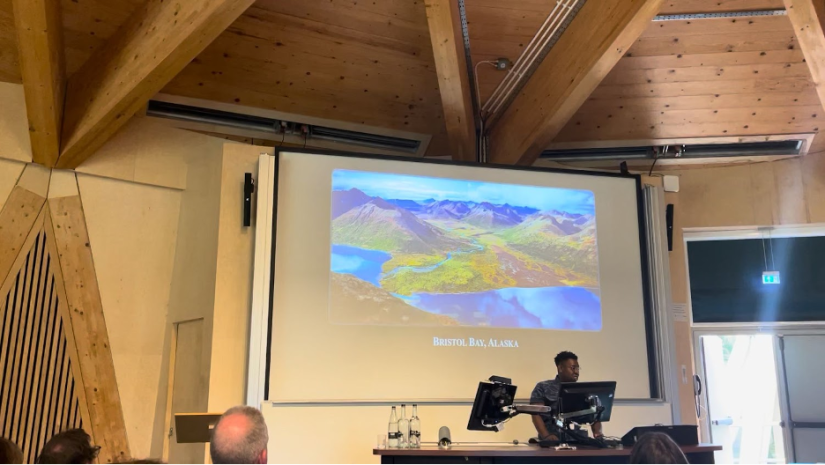
Moreover, the fellowship was a platform for me to enhance my other competencies, notably in technical writing, computer programming, and graph development. These skills were crucial in creating impactful visual and written narratives that underpinned the success of my project. They also significantly contributed to leading and advancing the department’s Sustainable Shoreline Program’s monitoring and reporting this year. The data and insights I generated played a pivotal role in advancing our team’s effort to highlight the effectiveness of a newly restored habitat along the Duwamish River and significantly contributed to the department’s broader mission of rehabilitating salmon ecosystems as well. Overall, this experience was instrumental in my growth as a scientist, providing me with a richer, more nuanced understanding of habitat restoration.
How was this fellowship useful for your future?
The fellowship program significantly honed my expertise in several key areas. Firstly, I developed proficiency in project management and logical coordination, essential skills for effective leadership and team collaboration. My engagement with spatial analysis deepened through learning ArcGIS on the job, which notably improved my ability to analyze and interpret geographical data, a critical skill in environmental research. I also gained more fieldwork experience, including the use of new surveying applications, conducting fish sampling, and employing a fyke net for ecological research. The fellowship also underscored the value of independent work, encouraging me to become more resourceful and proactive.
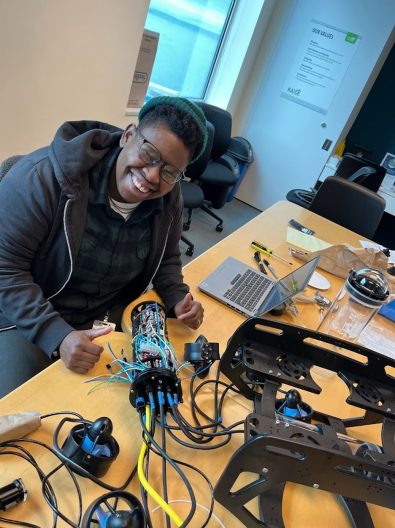
From an academic perspective, the program offered an immersive exploration into shoreline sustainable development. I gained in-depth knowledge of mitigation banking and blue carbon sequestration, moving beyond theory to grasp detailed aspects such as sector-specific terminology, methods of qualitative and quantitative analysis, and identifying success metrics in sustainable practices. This comprehensive understanding has significantly broadened my perspective on environmental sustainability.
These acquired skills and knowledge are not only pivotal for my imminent career post-Ph.D., but they also align with the needs of future employers in the environmental and sustainability sectors. Possessing these competencies will enhance my job prospects, making me a valuable asset to organizations dedicated to environmental conservation and sustainable development.
Supporting Tribal-led salmon monitoring using computer vision
UW researchers are developing a drone-based salmon survey method that the Sauk-Suiattle can use to manage resources.
WhaleVis turns more than a century of whaling data into an interactive map
A team at UW, including Trevor Branch from SAFS and Zoe Rand from QERM, have created an online interactive map called WhaleVis, which lets whale researchers visualize the IWC’s data on global whale catches and whaling routes. From this, researchers can estimate the animals’ spatial distribution and the effort whalers put into hunts.
Celebrating LGBTQ+ in STEM
Celebrating and highlighting the work of LGBTQ+ people in science, technology, engineering, and math (STEM) has a special day on the calendar: November 18. Why this date? It is based on the 60th anniversary of American Astronomer and gay activist Frank Kameny’s fight against workplace discrimination, which he took to the U.S. Supreme Court.

Science is a place of innovation, research, and progress, but many communities are still marginalized in these spaces. Pride in STEM notes that 28% of LGBT+ people have considered leaving their jobs because of discrimination or workplace hostility.
On LGBTQ+ in STEM Day, we celebrate the contribution of LGBTQ+ scientists, while also recognizing that barriers are still faced and that efforts have to continue to break these down. We spoke with SAFS graduate student, Aspen Coyle, who shared her thoughts on her journey so far in academia, what inclusion means for her, and some of the barriers and highlights she’s experienced. She also shares some advice for those concerned about a lack of representation in marine science.
For more information on Diversity, Equity and Inclusion activities and support at SAFS, visit our DEI page. For UW-wide resources, visit The Q Center.
What led you to pursue studies in science?

I’m one of those people that’s wanted to be a marine biologist ever since I was a little kid. I grew up in a fishing town in coastal Alaska, and my favorite thing in the world was scrambling along the intertidal, peering into tidepools and turning over rocks, trying to find the neatest critters. That base delight in hunting for cool creatures was augmented in undergrad with a deeper understanding of the ecological importance, and then after getting a job in another Alaskan fishing town, the economic importance.
What are some of the positive experiences as LGBTQ+ in STEM that you’ve had?
From an outside perspective, I’ve existed in several different modes as a queer person in STEM – up until recently as a queer guy, and for the last six months or so as a transfemme. Before grad school, I was working for the Alaska Department of Fish and Game in a variety of fieldwork positions. Being queer in rural Alaska, especially around the fishing industry, is often met with confusion (and occasionally, mild hostility), but I never felt much of that from my coworkers.
Here at SAFS, my lab is mostly other queer people, which has been wonderful. When I was living as a queer guy, it was really great to have a bunch of people around with this shared experience and perspective. And since queer cis people are usually around more trans people than straight cis people, it really wasn’t that big of a deal when I started transitioning.
What does inclusion look like for you?
Most people in the U.S. don’t personally know a single trans person, which means their idea of trans people is based on whatever they’ve picked up from media they’ve consumed. And generally, that means they’ve got some very strange ideas around trans people. For me, inclusion means not having those ideas projected onto me. I feel included when people are seeing me as an actual individual, as a three-dimensional person, when my transness is an aspect of me without it becoming my entirety.
Have you faced any barriers?
My first job post-undergrad involved month-long surveys at sea, and generally had a pretty macho atmosphere. I stayed closeted to my coworkers and crew (despite regularly calling my boyfriend on the ship’s satellite phone – I definitely spent a lot of effort being intentionally vague with pronouns). I’ve also certainly had some odd interactions with coworkers, especially around being trans.
The biggest barrier is probably one I haven’t yet faced – figuring out a job after graduation. Seattle is one of the best places in the U.S. to be trans. Unfortunately, most marine science jobs – especially those involving substantial amounts of fieldwork – are in areas that aren’t exactly trans-friendly. At this point, I’m not going to choose to live in an area where I’ll get stared at walking down the street, or where my access to HRT might be threatened in the future, so if I can’t find a job in a major city, I’ll probably have to leave marine science altogether.
Do you have any advice for others wanting to pursue studies or a career in STEM, but have concerns around lack of representation?
There’s definitely a lack of representation of queer people (and especially trans people) in marine science, but most scientists are pretty accepting too, even if they don’t “get it”. That means generally, the issue is finding a sense of community and connection rather than dealing with outright hatred. Because of that, I really, really recommend working on building community outside of grad school. I think that’s generally good advice no matter who you are – if all your friends are people in your grad program, it’s easy for your life to start revolving completely around grad school, which is a recipe for burnout. But if you’re queer in marine science, it’s extra important.

